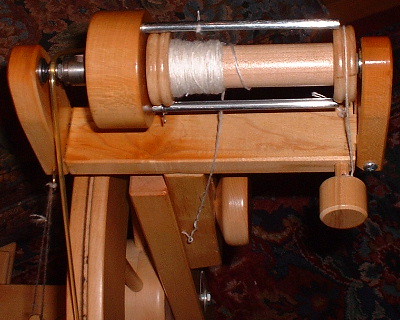Peasant Cloth
I originally entitled this post A Few Quick Answers, but I went beyond brief. I do want to answer a few questions I've received though, from last week's posts:
First of all, the angora in my scarf is from Bay Colony Farm, in MA. I spun it, and the cashmere, on my Lendrum with the Very Fast Head:

(You can see I'm back to spinning silk.)
And, as Lisa points out, few peasants had access cashmere or angora, so can I actually still call my cashmere scarf peasant cloth? I think so, because it's the spinning and weaving style that I use to define it. I believe it's well spun yarns sett close and beaten with a firm beat that make for durable cloth, no matter what the fiber content.
Pre-Industrial people invested precious time in their personal cloth production, and that cloth needed to be as durable as possible. Laura J discussed the book Woven Into The Earth, which I am reading, and the fabric samples unearthed in Norse Greenland. These textiles were primarily woven of smooth, uniform singles with a tight twist angle of 40° or more, woven closely sett at 25 to 30 epi. There are rarely any kinked threads, indicating firm control over such highly twisted threads. The warp-weighted looms probably aided in this, but the weft must have been under control in some manner too.
I choose to make my *peasant cloth* from plied yarns, sett close, more on the Andean model (although not *as* tightly spun, nor *as* closely sett):

There are over 100 samples here, cottons and silks, woven over the last 15-20 years. The fabrics for clothing are sett closer than I would, say, for a dishtowel, because I want them to be durable. I wear most of my clothing as *everyday* wear, not special event clothing, so it has to stand up to my daily life events.
So yes, I think silk can be *peasant cloth*, and cashmere, angora, alpaca, merino, and all the luxury fibers we can buy today. Aren't we lucky, to have access to all the fibers of the world, and the time and good fortune to spin up any fiber we want?
First of all, the angora in my scarf is from Bay Colony Farm, in MA. I spun it, and the cashmere, on my Lendrum with the Very Fast Head:

(You can see I'm back to spinning silk.)
And, as Lisa points out, few peasants had access cashmere or angora, so can I actually still call my cashmere scarf peasant cloth? I think so, because it's the spinning and weaving style that I use to define it. I believe it's well spun yarns sett close and beaten with a firm beat that make for durable cloth, no matter what the fiber content.
Pre-Industrial people invested precious time in their personal cloth production, and that cloth needed to be as durable as possible. Laura J discussed the book Woven Into The Earth, which I am reading, and the fabric samples unearthed in Norse Greenland. These textiles were primarily woven of smooth, uniform singles with a tight twist angle of 40° or more, woven closely sett at 25 to 30 epi. There are rarely any kinked threads, indicating firm control over such highly twisted threads. The warp-weighted looms probably aided in this, but the weft must have been under control in some manner too.
I choose to make my *peasant cloth* from plied yarns, sett close, more on the Andean model (although not *as* tightly spun, nor *as* closely sett):

There are over 100 samples here, cottons and silks, woven over the last 15-20 years. The fabrics for clothing are sett closer than I would, say, for a dishtowel, because I want them to be durable. I wear most of my clothing as *everyday* wear, not special event clothing, so it has to stand up to my daily life events.
So yes, I think silk can be *peasant cloth*, and cashmere, angora, alpaca, merino, and all the luxury fibers we can buy today. Aren't we lucky, to have access to all the fibers of the world, and the time and good fortune to spin up any fiber we want?

2 Comments:
Those samples are lovely....and a nice way of documenting your work.
You weave, therefore you are?
Oh I totally agree with you in all respects, especially the value you evidently and rightly assign to this kind of weaving. I'm just not so sure about calling something--anything--"peasant." The word has such deeply rooted, perjorative, and just plain highly questionable connotations & assumptions packed into it that I'm not sure it can be rescued. I see that you are rescuing it, though. Personally, I would ditch the word altogether. But that's just me. My dissertation chair once told me that I didn't have to question everything--I questioned that....Ha! :)
Post a Comment
<< Home